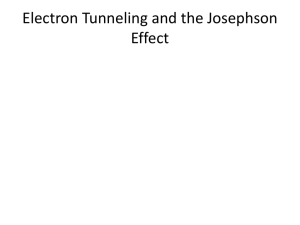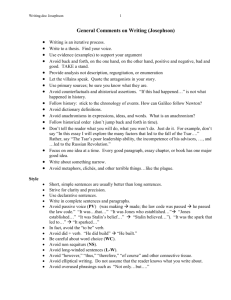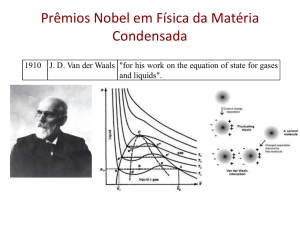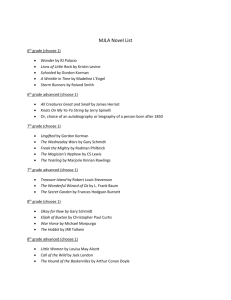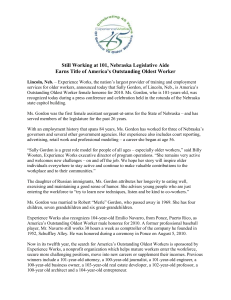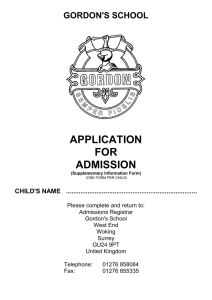Document
advertisement
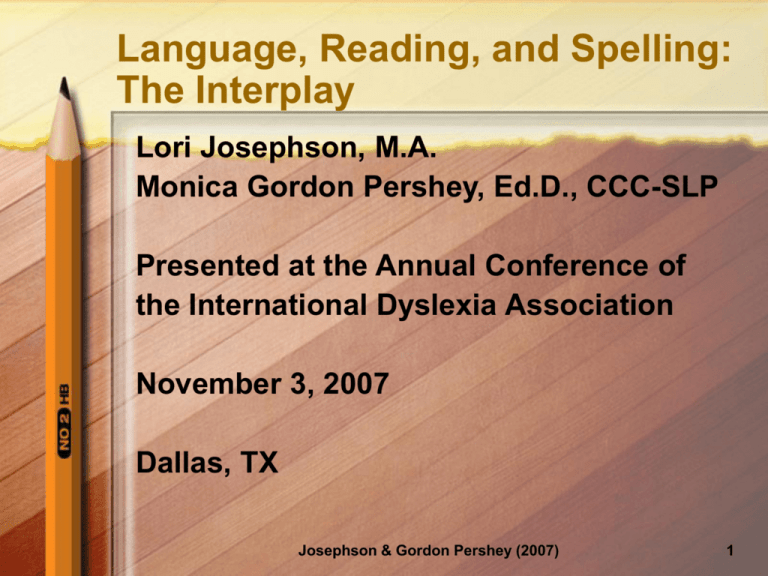
Language, Reading, and Spelling: The Interplay Lori Josephson, M.A. Monica Gordon Pershey, Ed.D., CCC-SLP Presented at the Annual Conference of the International Dyslexia Association November 3, 2007 Dallas, TX Josephson & Gordon Pershey (2007) 1 Oral Language: Connection to Academics Oral Language Forms the Underpinnings for the “Essential Components of Reading Instruction”: – Phonemic Awareness – Phonics – Vocabulary Development – Reading Fluency (Oral & Silent) – Reading Comprehension Strategies Josephson & Gordon Pershey (2007) 2 Oral Language: Connection to Academics Development of Written Language Skills: – Spelling – Writing to the Audience – Sentence Structure (Syntax/Grammar) – Retrieval of Oral Vocabulary – Sequencing (Phonemes, Words, Ideas) – Organization of Thought – Active Working Memory: Remembering What You’ve Written and What You Still Want to Write Josephson & Gordon Pershey (2007) 3 Oral Language: Connection to Academics Content Area Instruction – The Language of Mathematics Vocabulary Syntax Multiple Meanings – Social Studies/Science Vocabulary Abstract Thinking Precise Observation/ Measurement Drawing Conclusions Josephson & Gordon Pershey (2007) 4 Oral Language: Three Systems Semantics = “Content” - Making Meaning - Vocabulary - Specialized Lexicon - Concept Development - Breadth, Depth, and Connections - Contextual Usage and Analysis of Words - Structural Analysis of Words Josephson & Gordon Pershey (2007) 5 Oral Language: Three Systems Syntax = “Form” - Phonology: Phonemes, Syllables, Intonation, Stress, Pauses - Content Words: Nouns, Verbs, Adjectives, Adverbs - Function Words: Preposition, Conjunction, Auxiliary Verb, Article, Pronouns - Morphology: Affixes, Inflection, Contractions - Word Order: Clauses, Sentence Types, Question Words, Negation Josephson & Gordon Pershey (2007) 6 Oral Language: Three Systems Pragmatics = “Use” = In Context - Message Function: Intent and Purpose (To Inform, To Question, To Joke, To Form Attachment) - Message Cohesion: Successive Utterances Follow Logically, Maintain a Topic, Change a Topic, Lead Up to a Point, Sequence - Discourse: A Text (A Passage, A Book, An Advertisement, A Conversation, A Movie); A Genre Josephson & Gordon Pershey (2007) 7 Oral Language: Three Systems Linguistic Clarity Meet the Informational Needs of the Listener Logical Sequence Economy Expressivity Self-Monitoring Executive Function Social/Cultural/ Gender/Age/Setting/ Interlocutors Cooperation Turn-Taking Politeness Status/Role Topic Selection Nonverbal Language Self-Monitoring Executive Function Josephson & Gordon Pershey (2007) 8 Oral Language: Three Systems Pragmatic skill is judged by criteria of social validity - success in a social field Listener evaluations are dependent upon culturally conditioned values that dictate credibility: wealth, appearance, physical fitness Linguistic/cognitive competence may or may not predict social competence Social competence may mask linguistic/cognitive deficits Josephson & Gordon Pershey (2007) 9 Oral Language: Three Systems Bloom, L. Pediatrics 1998;102:e1272 Copyright ©1998 American Academy of Pediatrics Josephson & Gordon Pershey (2007) 10 Form Articulation/Auditory Discrimination Phonological Processing/Phonemic Awareness – Manipulation Affects Reading/Spelling (Blending, Segmenting, Elision, Substitution) – Phonological Memory Affects Retrieval (Spelling) Receptive/Expressive Production Errors Phonological Neighbors Syntax (Function Words, Prepositions) Active Working Memory - Metalinguistic Long Term Memory Josephson & Gordon Pershey (2007) 11 Components of Language and Academic Instruction - Form Reading Readiness - Development of Phonological Awareness, Memory, Rapid Naming Ability Reading Decoding/Spelling – Word and Sentence Level Oral Reading Fluency Written Sentence Construction Math Formulae Sequencing of Steps in Math Calculation Josephson & Gordon Pershey (2007) 12 Meet Matthew Presented in Spring of Kindergarten History of Speech; Brothers Need(ed) Intervention Poor Articulation - /k/, /g/, /l/, /r/ Poor Discrimination - k/g, f/th/v Overall Intelligibility Poor Poor Oral Language Affected Development of Rhyming, Phonological Awareness, Sound/Symbol Relationships, Development of Sight Word Vocabulary CTOPP (age 6): Average Phonological Awareness and Rapid Naming; Below Average Phonological Memory Josephson & Gordon Pershey (2007) 13 Meet Matthew DIBELS: Steady Growth Throughout 1st Grade Nonsense Word Fluency: 22 (fall), 52 (winter), 94 (spring) - At Benchmark Oral Reading Fluency: 21wpm (winter); 55wpm (spring); 59wpm (fall 2nd grade) - At Benchmark Retell Fluency: 15 (winter); 30 (spring); 15 (fall 2nd grade) - Variable Difficulty Using Correct Syntax at Times; Irregular Past Tense Shaky: ‘Tooken Out’ for ‘Taken Out’ Josephson & Gordon Pershey (2007) 14 Meet Matthew Results of Intervention Have Been FABULOUS!!! Articulation Correct Except /r/ Medial Decoding/Encoding VERY Good for What Has Been Taught: 3, 4, 5 Sound Words; Suffixes s, es, er, est, ed, ing; Schwa; Nasals; Rules of Syllabication Using Closed Syllable Words Fluency is At and Above Benchmark At Times, Difficulty Pronouncing Multisyllable Words: Magnifying Josephson & Gordon Pershey (2007) 15 Meet John Presented In 1st Grade: History of Speech/Language Issues; Family History of Delayed Language/Speech – Poor Intelligibility – Poor Sound Discrimination – Poor Visual-motor Skills (Handwriting/ Motor Planning Problems) Josephson & Gordon Pershey (2007) 16 Meet John – Average Reading: Sound/Symbol Relationships (When Discriminated Appropriately); Poor APPLICATION of these Skills for Decoding Nonsense Words and Encoding; Slow to Learn Nonphonetic Sight Words for Spelling - Poor Spelling: Phonetic Speller Based Upon Faulty Articulations: ‘Wif’ for ‘With’ Josephson & Gordon Pershey (2007) 17 Meet John Early Intervention: 1st and 2nd Grades – Improvement In Articulation and Intelligibility – Attended Speech Therapy - Work on Articulation and Intelligibility, Pronunciation of Multisyllabic Words – Impulsive Work Style: Reads Many Words Per Minute with Many Errors (Omissions of Suffix Endings/ Function Words) – Improvement in Decoding and Encoding; Syllabication Skills- Grade Level Work Josephson & Gordon Pershey (2007) 18 Meet John Continued Remediation: 3rd-4th Grades – Released From Speech Therapy - 4th Grade – Continued Improvement in All Areas – Able to Blend/Segment Sounds in up to 6 Sound Words- Impulsive Work Style Continues to Interfere with Spelling Mastery (Sound Omissions/ Substitutions) Josephson & Gordon Pershey (2007) 19 Meet John Continued Remediation: – Knowledge of Syllable Types: Closed, Open, Vowel-consonant-e, Consonant-le – Knowledge of Rules of Syllabication – Knowledge of Basic Latin Suffixes – Improvement in Sight Word Vocabulary for Spelling – Continued Difficulty Pronouncing Multisyllabic Words: ‘Twists’ Josephson & Gordon Pershey (2007) 20 Meet John Josephson & Gordon Pershey (2007) 21 Meet John Josephson & Gordon Pershey (2007) 22 Meet John Josephson & Gordon Pershey (2007) 23 Less Developed Oral Language Results in Persistent, Consistent Decoding Errors - Grade 5 Selection Josephson & Gordon Pershey (2007) 24 Content Vocabulary - One of the Best Predictors of School Success – Overall Lexicon (Academic) – Word Retrieval – Phonological Neighbors (Malapropisms) – Multiple Meanings – Antonyms/Synonyms Overall Productivity – Spoken Language – Written Language Josephson & Gordon Pershey (2007) 25 Content Morphology – Affixes – Root/Combined Forms Study – Word Derivatives Grammar/Word Function Semantic Neighbors – Precision of Usage Josephson & Gordon Pershey (2007) 26 Components of Language and Academic Instruction - Content Vocabulary Meaning in All Subject Areas (Alternate Meanings, Synonyms) Comprehension of Complex Text in Any Content Area Comprehension of Discourse (Spoken/Written), Subject Specific or for Social Purposes Ability to Read to Learn Vs. Read for Pleasure Josephson & Gordon Pershey (2007) 27 Components of Language and Academic Instruction - Content Understanding Figurative Language, Metaphors, Similes Critical Thinking Using the Vocabulary of Instruction/Vocabulary Internalized for Discourse Understanding the Language of Math and the Ability to Explain Solutions to Math Problems Josephson & Gordon Pershey (2007) 28 Revisit with John Oral Syntax has had a BIG Affect on Reading/Written Language Skills Use of Prepositions: For/So – “I Went to the Bank for I Could Get Money.” – Remediation Required Oral/Written Modeling Over a Long Period of Time Josephson & Gordon Pershey (2007) 29 Revisit with John Omission of ‘Function Words’/Suffix Endings While Reading Orally Ability to Create Sentences with Correct Usage Given Target Words with 1 and 2 Suffix Endings or Derivatives: Carelessly, Actively, Gracefully “He is all the time lately.” “He destructiveness knocked the building over.” Difficulty with Homophones, Multiple Meanings, Idioms Josephson & Gordon Pershey (2007) 30 More children…. Phonological Neighbors: – Russell (grade 4): Budge/budget – Alex (grade 8): Instigate/imitate – Rachel (grade 7): anecdote/antidote Josephson & Gordon Pershey (2007) 31 Meet Kendra Presented in Grade 6 Vocabulary/Productivity/Grammar: - Overall Productivity In Oral Language Domain - Wordy Written Language - Poor Syntax/Low Vocabulary Level - Poor Receptive and Expressive Vocabulary due to Both Low Overall Language Skills and Reduced Reading Experience - Deficits in Word Retrieval - Poor Recognition of Patterns Affects Morphology (Affixes, Roots) - Poor Imagery - DISCONNECT Between Oral Language Grammar - Written Language Josephson & Gordon Pershey (2007) 32 Meet Kendra In chapter 5 Jonas and his famil y talk about the dream that they had that night. JonasÕ s dream was a li ttle awkward, his parents told Jonas that it was the being o f Stirrings. Stirrings begins in a dream. I think Stirrings means when a boy starts to li ke a girl or the other way around. Jonas has to start taking pill s through his whole adult hood. Everyone has to do the same when it happens to them. In chapter 6 there is a ceremony and everyone turns a year older at the same time. When they turn a year older they get a gift. Lily is turning 9 and is getting a bicycle. Jonas is turning 12 and is getting to get a job. In chapter 5 Jonas and his famil y discuss the dreams they all had the previous night. It was awkward for Jonas to talk about his dream since it dealt with adolescent feeli ngs; his parents told Jonas that it was the beginning of Stirrings. JonasÕ s mother explained that Stirrings begin in a dream, and all chil dren his age have them. I think Stirrin gs refers to the romantic feeli ngs that boys and girls have to ward each other. His mother goes on to explain that Jonas must take pill s through his whole adulthood in order to dimi nish Stirrings altogether. This society requires everyone his age to take pill s to elimi nate Stirrings. Chapter 6 involves a ceremony when everyone tur ns a year older at the same time (sim ultaneously ). When the chil dren in the community turn a year older, they receive a gif t, which is the same depending o n the chil dÕ s age. All eight year olds, such as Lil y, receive a jacket with small er butto ns down the front showing her independence. Jonas, li ke the ot her twelve year olds, receives a job Assignment. Josephson & Gordon Pershey (2007) 33 Meet Amanda TOWL Grade Equivalent 4.4 Josephson & Gordon Pershey (2007) 34 Meet Andrew Presented in Kindergarten - ‘Over-Focusing’ - Slow to Follow Directions - Attentional Difficulties - Difficulty with Transitions - Mild Anxiety Issues - “Loses Track of Time” - Relatively Weak Handwriting Skills - ‘Phonics’ Deemed Intact Josephson & Gordon Pershey (2007) 35 Meet Andrew Assessment Results: – Sound/Symbol Relationships Intact; Poor APPLICATION for Decoding/Encoding – Difficulty Recognizing and Spelling Nonphonetic Sight Words; Both Affecting Fluency – Underlying Difficulty with Language: Days of the Week, Months of the Year, Seasons, Holidays Address, Telephone Number Overall Weak Vocabulary Josephson & Gordon Pershey (2007) 36 Meet Andrew Andrew’s ‘Disconnected’ Language Skills CREVT Scores: Receptive Vocabulary 37th Percentile Expressive Vocabulary 19th Percentile Josephson & Gordon Pershey (2007) 37 Meet Andrew Receptive Errors Josephson & Gordon Pershey (2007) 38 Meet Andrew Expressive Errors: – ‘dog’ - “goes outside and pees” – ‘oven’ - “it’s hot” – ‘lemon’ - “put it in drinks” Ongoing Difficulties with Categorizing/ Naming, Synonyms, Antonyms, Multiple Meanings, Analogies – Naming Parts of a Car - “motor, door, air thing, drivers plate (license)” – “Car : drive as toy : Lego” – Baseball Unit - Naming - “bat, mitt, ball,” prompt “helmet, mask”; Multiple Meanings “park, fly, catch” – “Baseball : sport as cake : eat” Josephson & Gordon Pershey (2007) 39 Meet Andrew Andrew’s Handwriting/Process Speed Slow Process Speed - Beery VMI - 55th Percentile Summer 2006 Winter 2007 Josephson & Gordon Pershey (2007) 40 Use Pragmatics Affect Fluency and Comprehension Ability to Participate in Discourse Written Language Ability to Socially Interact Appropriately World Knowledge Josephson & Gordon Pershey (2007) 41 Components of Language and Academic InstructionPragmatics Understanding the Implicit Meaning As Well As Explicit Meaning in Literature and in Content Area Reading Understanding Humor Understanding Hidden Motivations of Characters in Literature, Leaders in History, Etc. Understanding Applications of Math Instruction in Everyday Life Josephson & Gordon Pershey (2007) 42 More children…. Kendra and Gabe: – Retellings Low Level in Terms of Production – Retelling Begins with the Final Sentence Read (Typically a Detail); No Main Idea Andrew (Grade 1): – Poor Eye Contact, Inattentive ADD, Affective Issues – Over-Focused on Details Josephson & Gordon Pershey (2007) 43 Meet Matt Presented in Grade 2: - Poor Decoding/Encoding - Comprehension Intact - Poor Handwriting Grade 5: Good Response to Tutorial - Fluency and Decoding Intact - Began to Experience Breakdown in Comprehension as Sentence Length and Text Complexity Increased (Appositives, Compound Sentences) - ‘Word-caller’ - Written Language Mechanical, Wordy Josephson & Gordon Pershey (2007) 44 Meet Matt Cave Paintings In the Cave of Lascaux, there are many cave painting of anim als made by cave men. I think the cave men must have been very intelli gent to think of how to make different colors out of different berries. I think they had to be interested in drawing to take the tim e to draw those cave paintings when they probably had better things they could do like hunt for food. I think they may have drawn these cave paintings because they wanted to show other people that they li ved here in the cave. Also, they may have wanted to keep learning about different ways they could have drawn on the cave wall s. I think they tried to keep history by drawing t hese pictures and they did a good job. In the Cave of Lascaux, many cave painting exist of anim als made by homosapiens. I think the cave men displayed intelli gence by thinking of how to make diff erent color paints out of berries. In addition, they appeared to have an interest in drawing and to take the tim e to draw the cave paintings when they probably had better things to do such as search for food. I beli eve they drew these cave paintings because they wanted to show others that they lived here in the cave. Their paintings depict various anim als in existence at that tim e. Also, they experim ented with different ways to draw on the cave wall s using rocks and berries. They attempted to record history by drawing these detail ed, well -done pictures on cave wall s. Josephson & Gordon Pershey (2007) 45 Meet Chris Josephson & Gordon Pershey (2007) 46 Implications for Instruction Task Analysis for Instruction: STRUCTURED----------------SPONTANEOUS Oral Language Production in a Structured Situation Oral Language Production in a Spontaneous Situation Written Language Production in a Structured Situation Written Language Production in a Spontaneous Situation Josephson & Gordon Pershey (2007) 47 Implications for Instruction Provide Interactive Lessons: – Lecture Format is Often Too Fatiguing for LD Students Speak Slowly: – Normal Rate: 130-250 Words Per Minute (Emerick & Haynes 1986) – Oral Reading Rate: 130-140 WPM Recommended – Delivery of Verbal Information at <200 WPM Recommended Josephson & Gordon Pershey (2007) 48 Implications for Instruction Directly Teach Vocabulary in EVERY Subject Area! Anticipate Student Needs! Don’t Assume Anything! – Consistently Review (Flash Cards, Game Format) – Teach Parts of Speech (Word Function) – Review Multiple Meanings as Necessary Josephson & Gordon Pershey (2007) 49 Implications for Instruction - Have Students Repeat Words - Students Use Words in Orally Generated Sentences - Avoid Assignments/Class Work Involving Predominantly Copying – Require More Active Learning Assessment: – Don’t Count Spelling Errors on Non-spelling Tests – Oral Assessments – Vary Test Formatting Josephson & Gordon Pershey (2007) 50 Teaching Strategies for Errors in Form – Provide Opportunities to Practice – Ask Clarification Questions: Do You Mean ____ Or ____? “If I Understand Correctly, You Said ___” – Paraphrase the Response: “So You’re Saying…” – “I’m Having Trouble Understanding” – Ask Another Student to Reverbalize – Analogy Between Handwriting Legibility and Speech Articulation Josephson & Gordon Pershey (2007) 51 Teaching Strategies for Errors in Form Errors In Production: – Provide Validation Rather Than “That’s Wrong”….That’s Very Close” Instead – Present ‘Sound-Symbol’ Cues – Use Gestural and/or Semantic Cues – Use Synonyms/Antonyms as Applicable Josephson & Gordon Pershey (2007) 52 Teaching Strategies for Errors in Form Syntax Errors: – Simple Sentences - Complex Sentences - Compound Sentences – Use of Templates to Practice Correct Word Order (Structured Speech, Spontaneous Speech, Structured Writing, Spontaneous Writing) – Gradual Elimination of the Templates – Provide Lists of Starter Words for Adverb Phrases: A ‘Menu’ Josephson & Gordon Pershey (2007) 53 Teaching Strategies for Errors in Content Typical Receptive and Production Errors: – Omission of Suffix Endings – Confusion of Suffix Endings – Omission of ‘Function Words’ – Subject-verb Agreement – Confusion of Subject-Object Pronouns – Use of Participles – Irregular Past Tense – Pluralization – Comparative/Superlative Adjectives Josephson & Gordon Pershey (2007) 54 Teaching Strategies for Errors in Content Disconnect Between Receptive Language and Production Grammar Instruction Fluency Drills - Highlight Element You Are Trying To Remediate Provide Practice With Oral Sentence Production/Written Sentence Production Provide Lists Of Verb Conjugations Provide Lists Of Subject/Object Pronouns Josephson & Gordon Pershey (2007) 55 Teaching Strategies for Errors in Content Fluency Drills - Highlight the Element You are Trying to Remediate Provide Practice with Oral Sentence Production/Written Sentence Production Provide Lists of Verb Conjugations Provide Lists of Subject/Object Pronouns Flash Cards - Matching Suffix to Word Function Direct Instruction on Word Derivatives Provide Lists of Adjectives (Menu) Josephson & Gordon Pershey (2007) 56 Teaching Strategies for Errors in Content Multisensory Grammar Instruction: Project Read Framing Your Thoughts www.projectread.com Neuhaus Multisensory Grammar www.neuhaus.com Josephson & Gordon Pershey (2007) 57 Teaching Strategies for Errors in Content for Older Students Directly Teach Sentence Combining: – Use of ‘And’- Compound Subject, Predicate – Use of ‘And’ ‘But’ ‘So’ - Compound Sentences – Use of Correlative Conjunctions: ‘Neither/Nor’; ‘Not Only/But Also’; ‘Either/Or’; ‘Whether/Or’ – Use of Connectives (Transition Words/ Phrases) – Adjective Placement Prior to Noun – Break Apart Combined Sentences into their Component Parts Josephson & Gordon Pershey (2007) 58 Teaching Strategies for Errors in Content for Older Students Directly Teach Elimination of Passive Voice – Use Active Verb Instead – Introduce Use of Appositive Use Commonly Confused Words by William W. Gentile, Sr. www.walch.com MODEL, MODEL, MODEL!!! Josephson & Gordon Pershey (2007) 59 Strategies to Teach Vocabulary Look IN the word, AROUND the word – Affixes – Identification of the Part of Speech/ Function of word – Identification of Roots/Combined Forms – Use Context Create a Semantic Map – Antonyms/Synonyms – Definition – Examples – Multiple Meanings – Linguistic Structure Josephson & Gordon Pershey (2007) 60 Strategies to Teach Vocabulary Oral/Written Sentence Formulation with Illustration Collins CoBuild Dictionary www.collins.co.uk Vanilla Vocabulary www.ganderpublications.com Roget’s Super Thesaurus by Marc McCutcheon (Writer’s Digest Books) Getting Into Words by Shira Lubliner www.brookespublishing.com Directly teach homophones, homographs, heteronyms (2 pronunciations - read/read Accent changes - conduct, object) Josephson & Gordon Pershey (2007) 61 Strategies to Teach Idioms and Figurative Language What Are We Talking About?? – Hyperbole – Idiom – Metaphor – Onomatopoeia – Personification – Simile – Slang – Proverb – Dialect – Figures Of Speech: Allegory, Irony, Euphemisms Josephson & Gordon Pershey (2007) 62 Strategies to Teach Idioms and Figurative Language Use Literature/Other Media Formats: – Prose/Poetry – Advertisements, Newspapers Direct Instruction/Multiple Exposures Illustrations Dictionary of Idioms by Marvin Terban www.scholastic.com Figurative Language: A Comprehensive Program by Kathleen A. Gorman-Gard (Thinking Publications) Webster’s New World American Idioms Handbook by Gail Brenner (Wiley Publishing) Josephson & Gordon Pershey (2007) 63 Josephson & Gordon Pershey (2007) 64 Teaching Strategies for Errors in Use Improving Discourse - Written Language: – Practice in Maintenance of Discourse on Topic - Use of Discourse Connectors, Transitions, Terminators – Practice in Oral Summarizing Identification of Main Idea and Supporting Details, Use of Discourse Connectors (Use of Template) – Practice Providing Descriptive Information (Use of Template) Josephson & Gordon Pershey (2007) 65 Teaching Strategies for Errors in Use - Practice in expressing: Comparisons/Contrasts Explaining a Process Describing Cause/Effect Opinions - Eliminate Open-Ended Questioning, Provide Multiple Choice Responses, Cueing, Brainstorming, Modeling Josephson & Gordon Pershey (2007) 66 Questions and Discussion Josephson & Gordon Pershey (2007) 67
